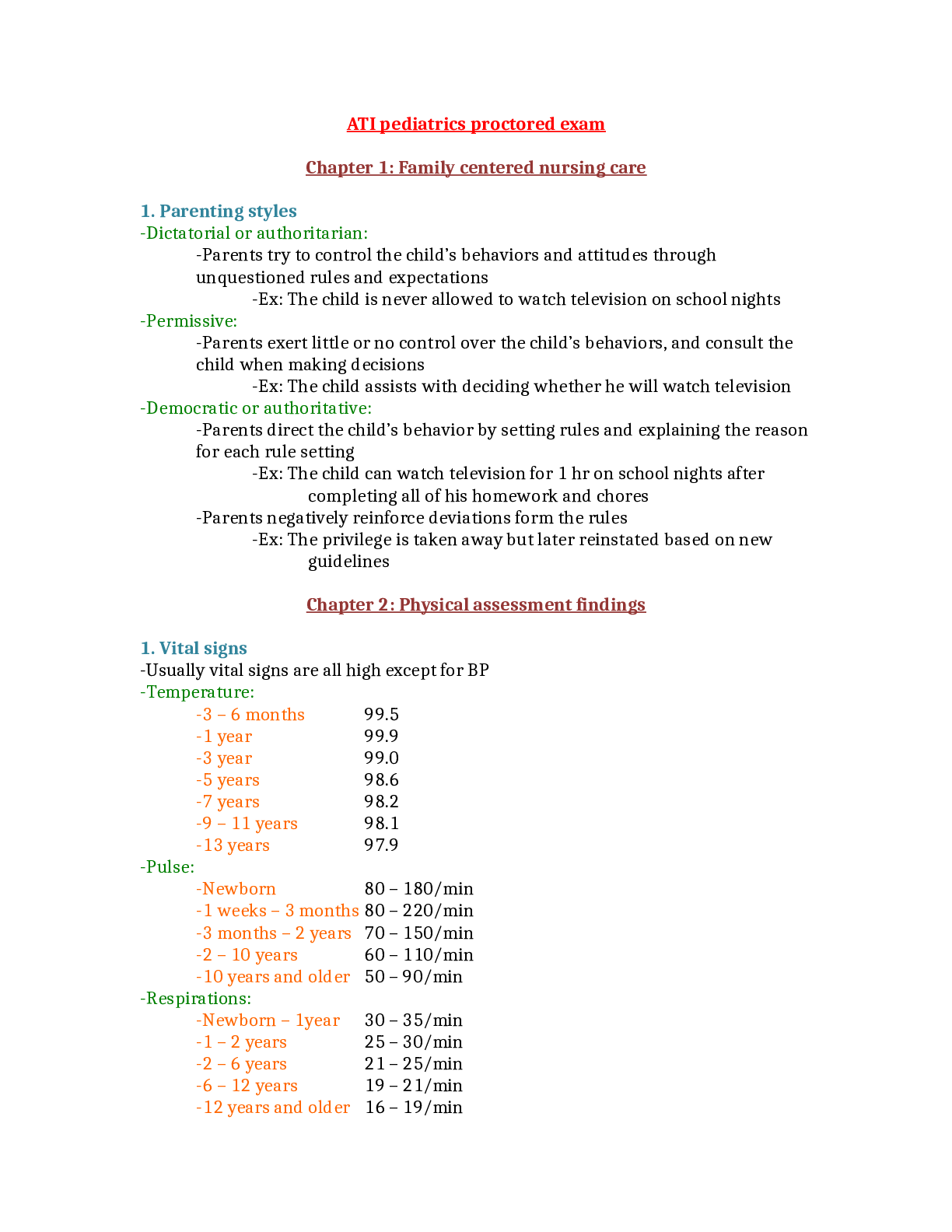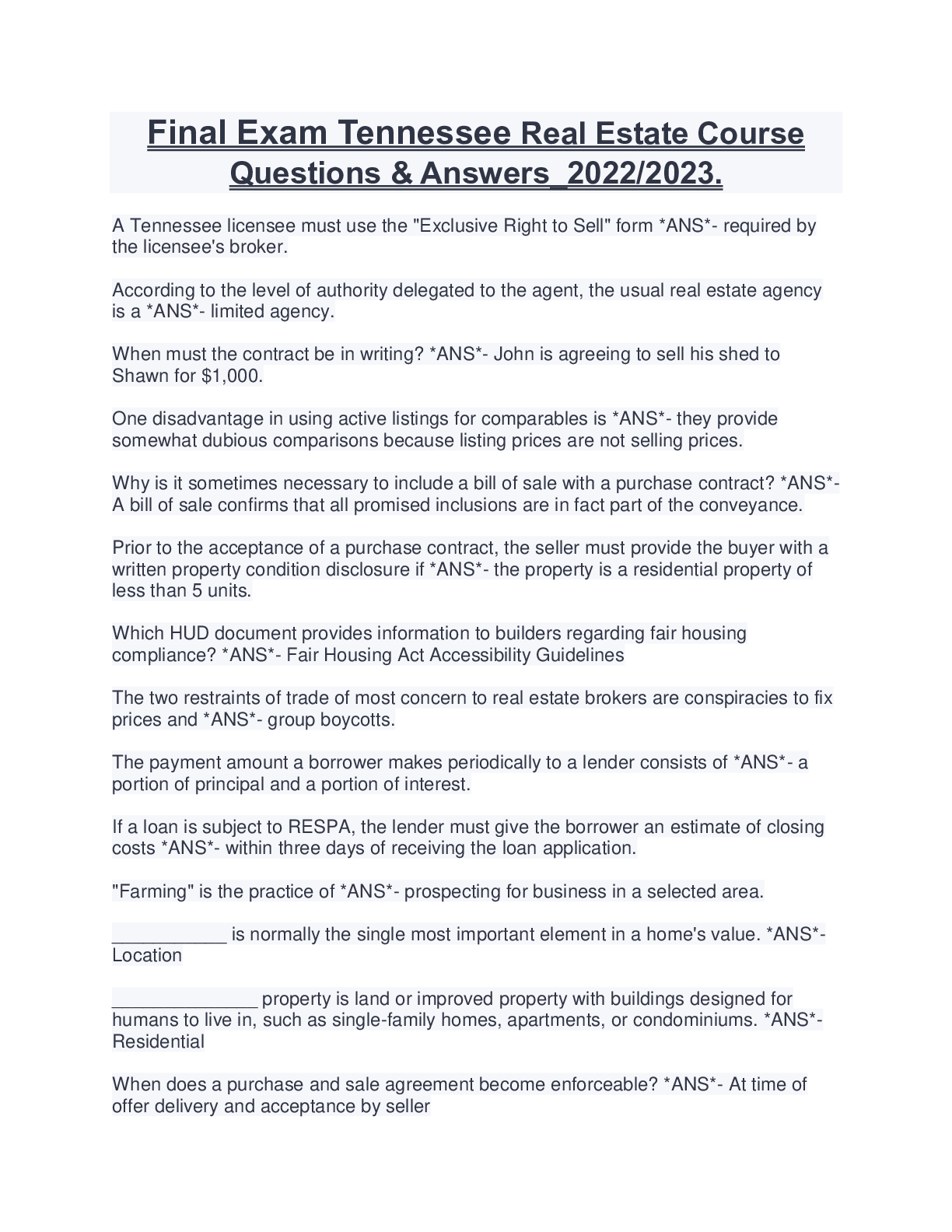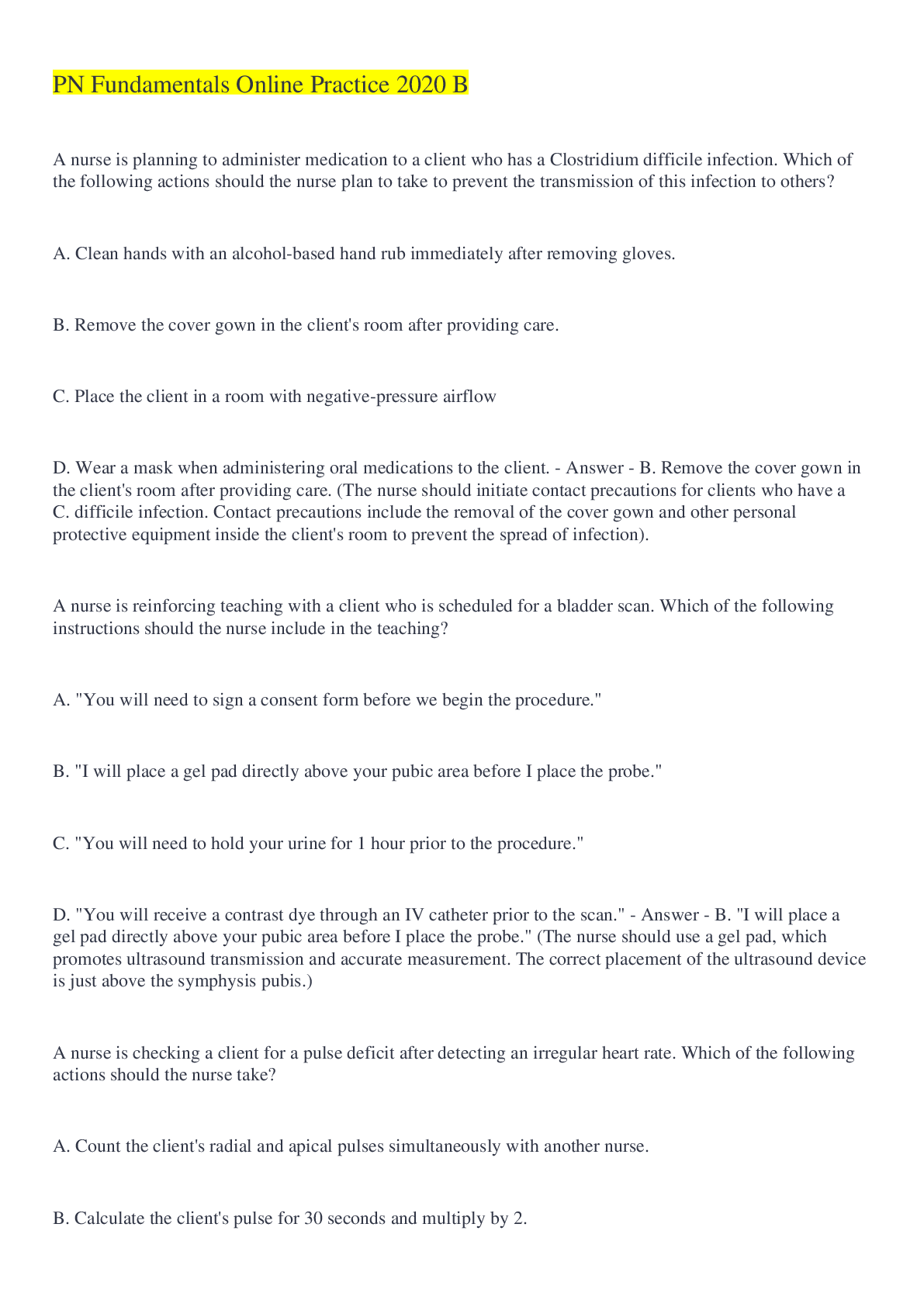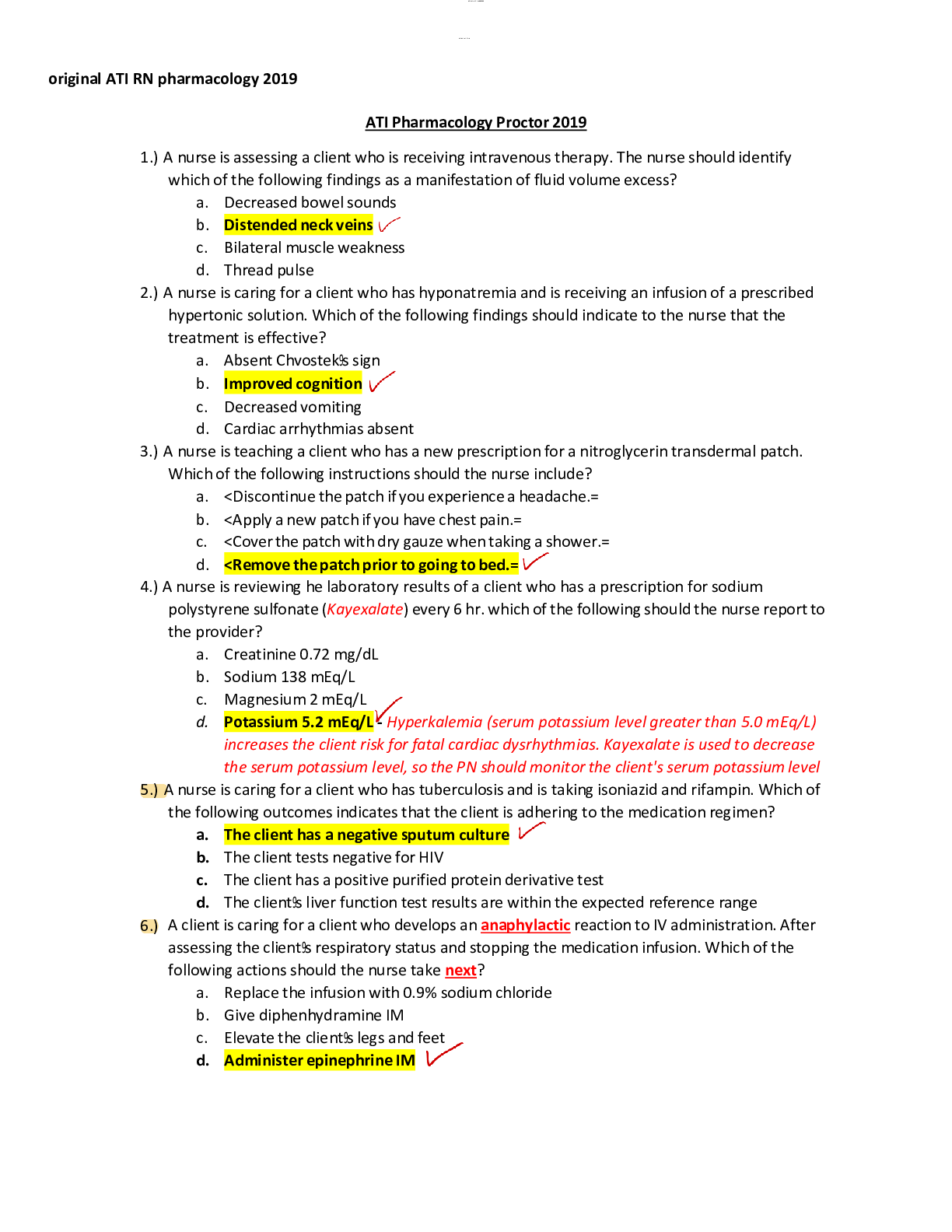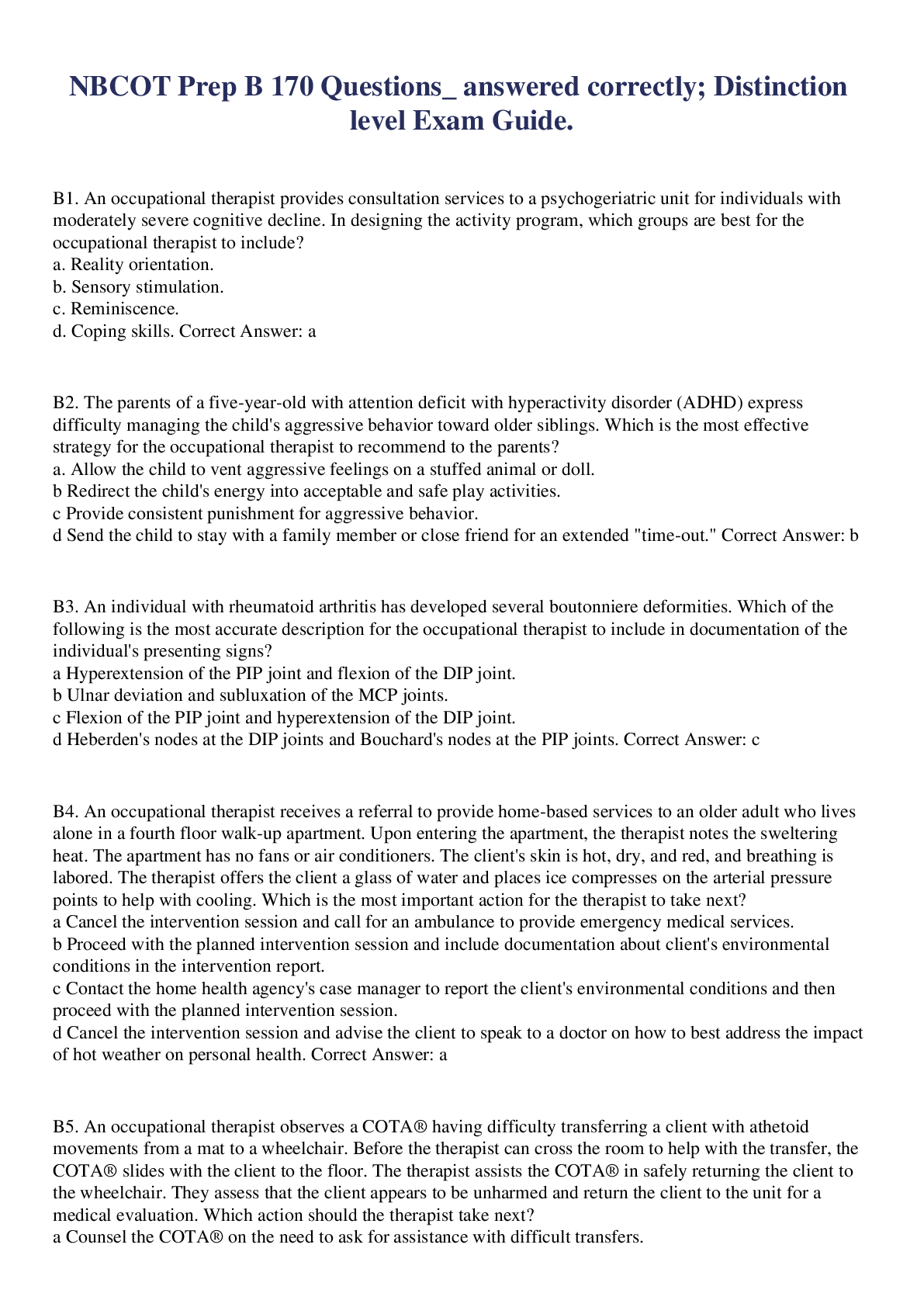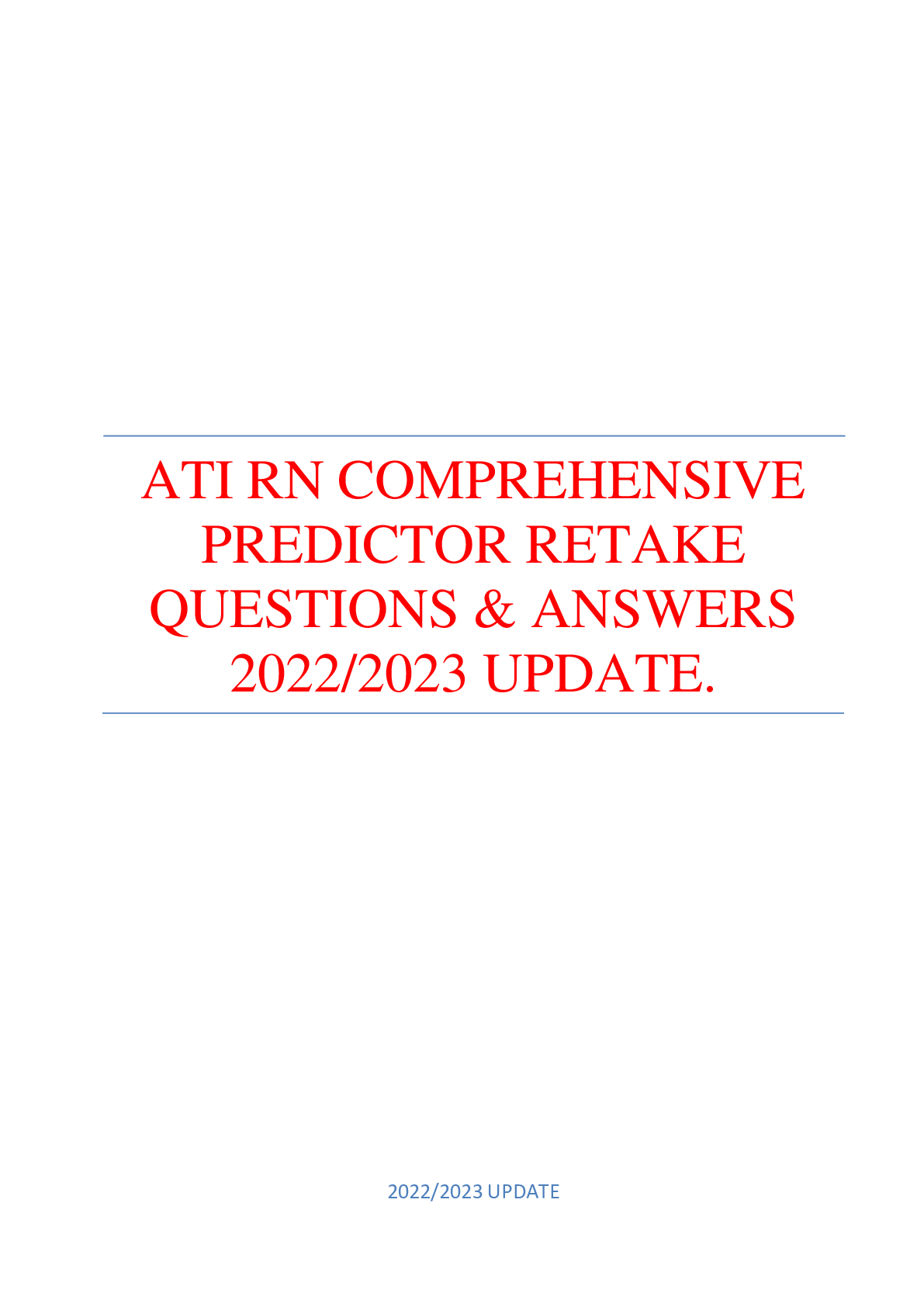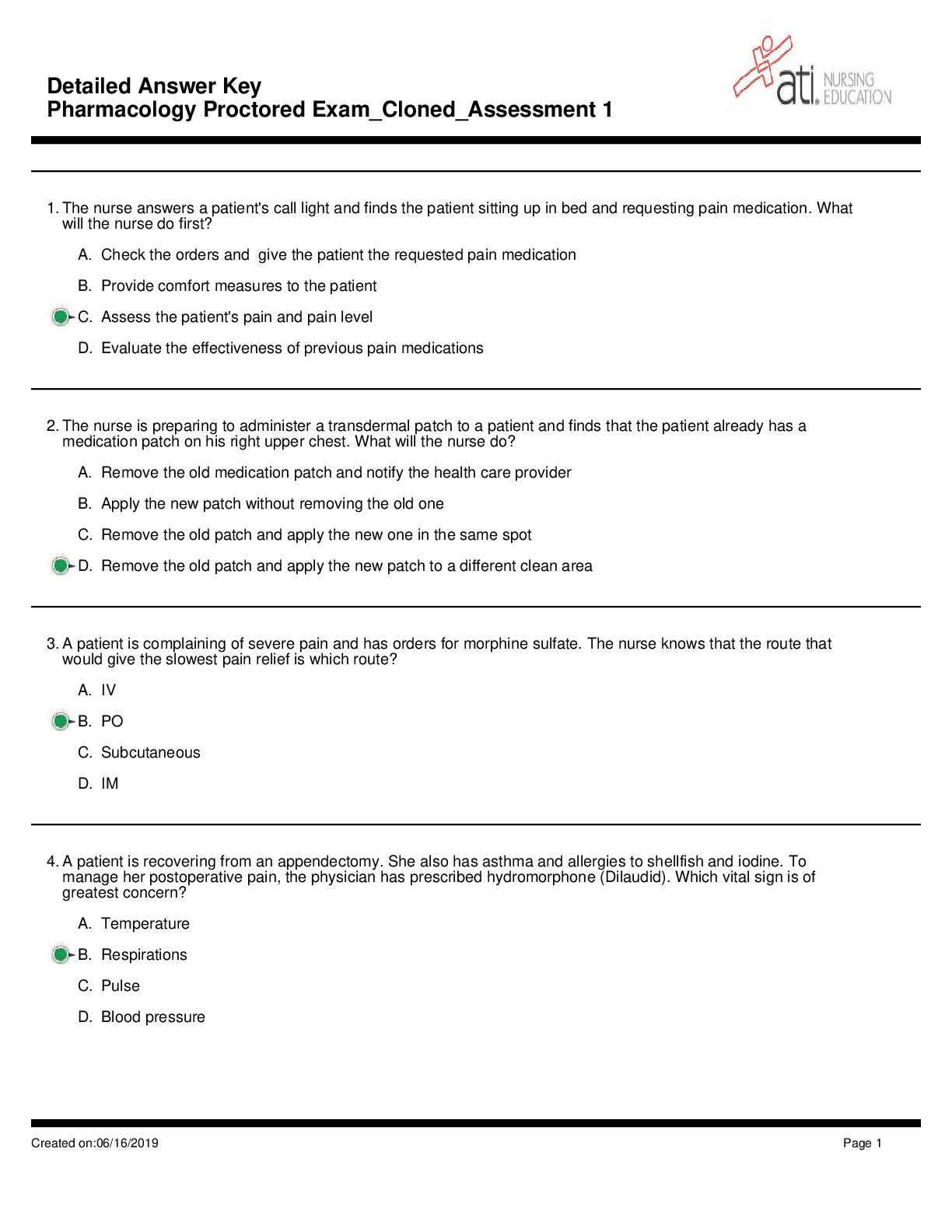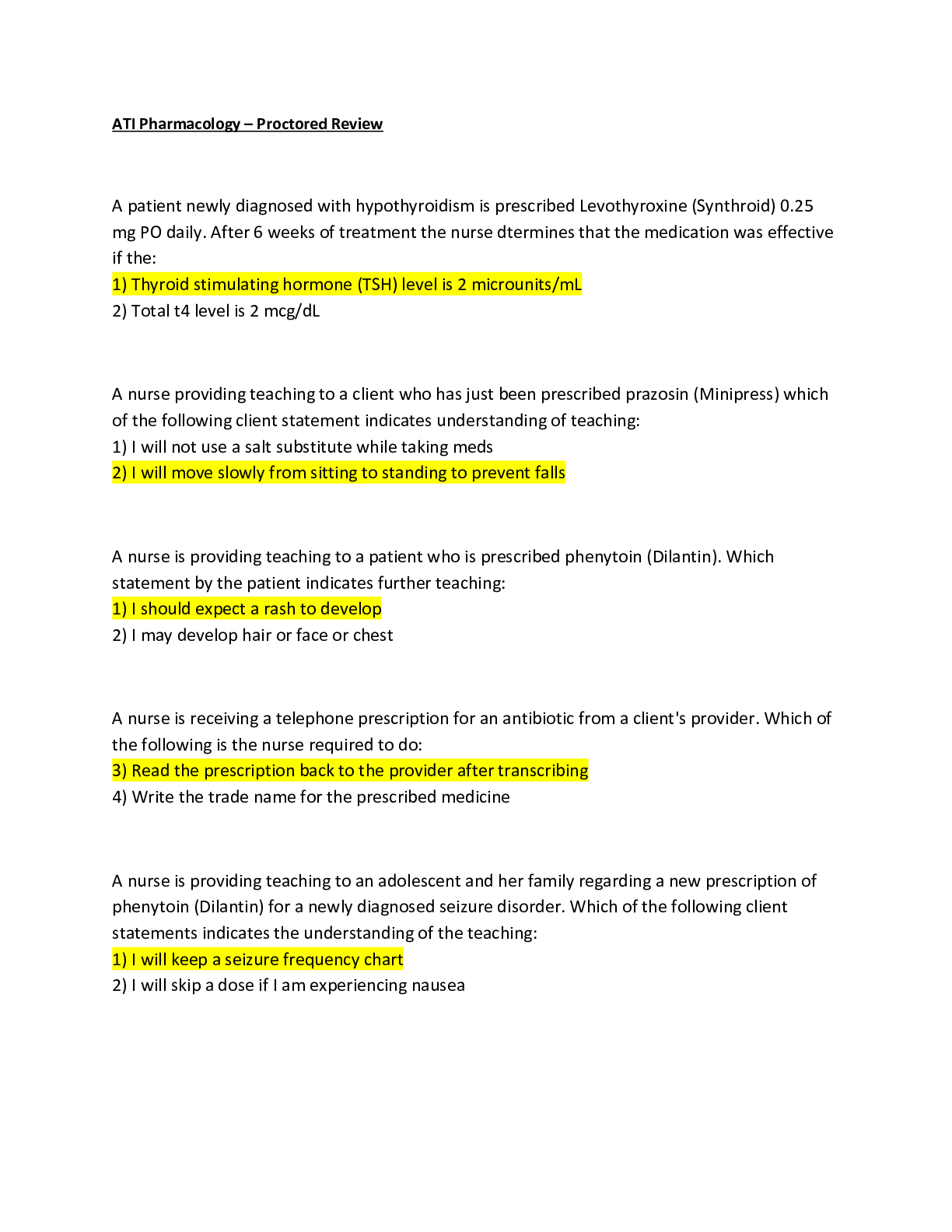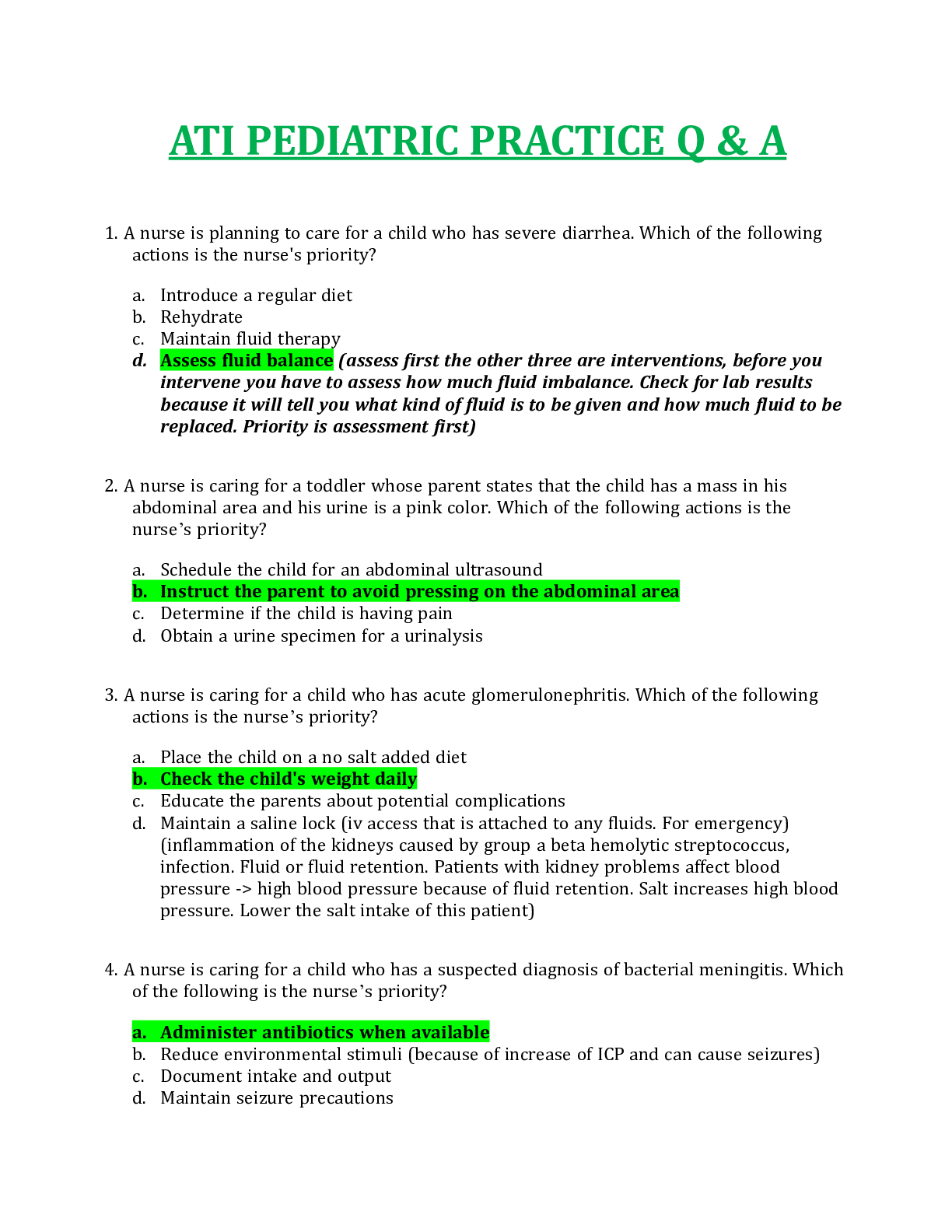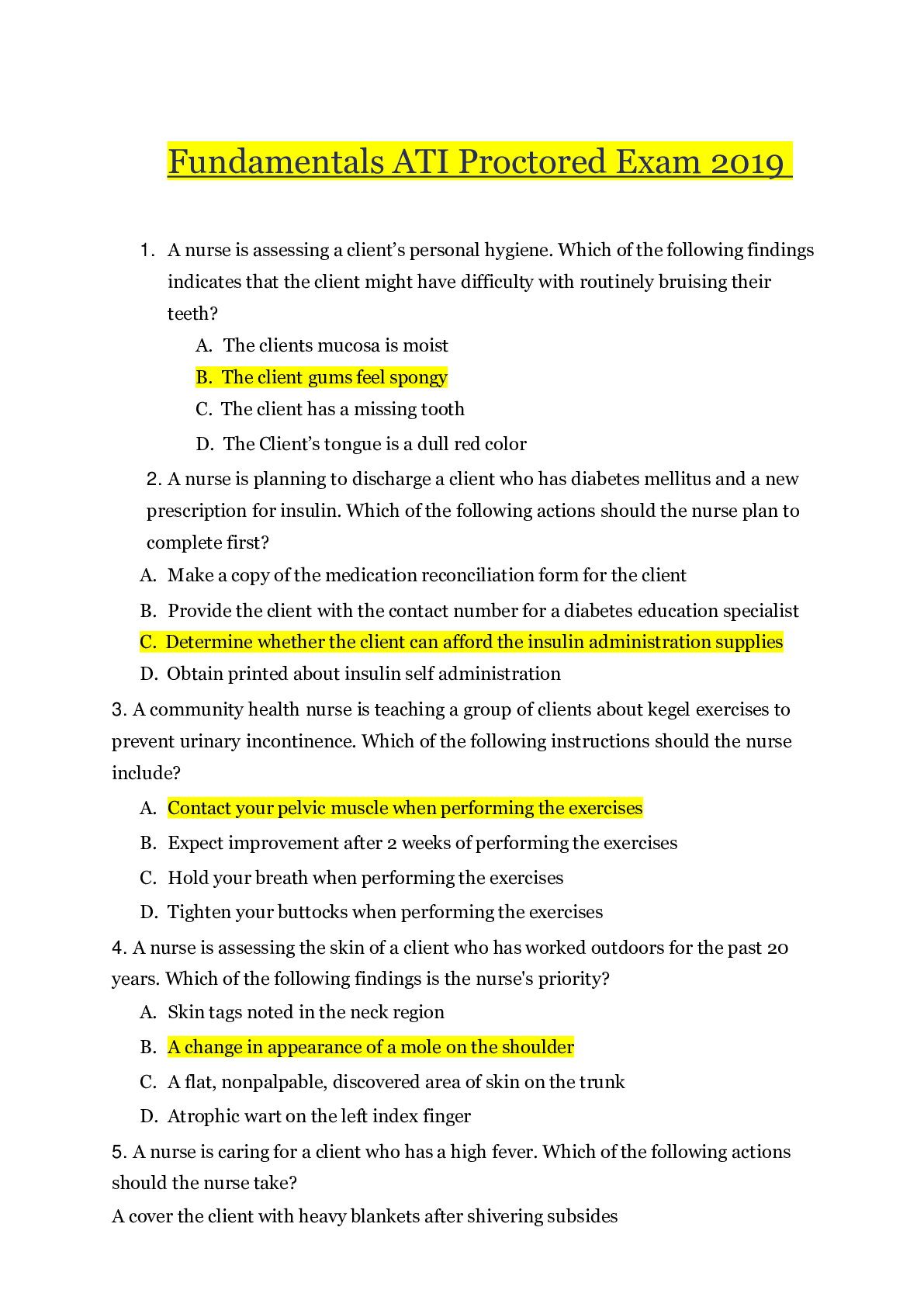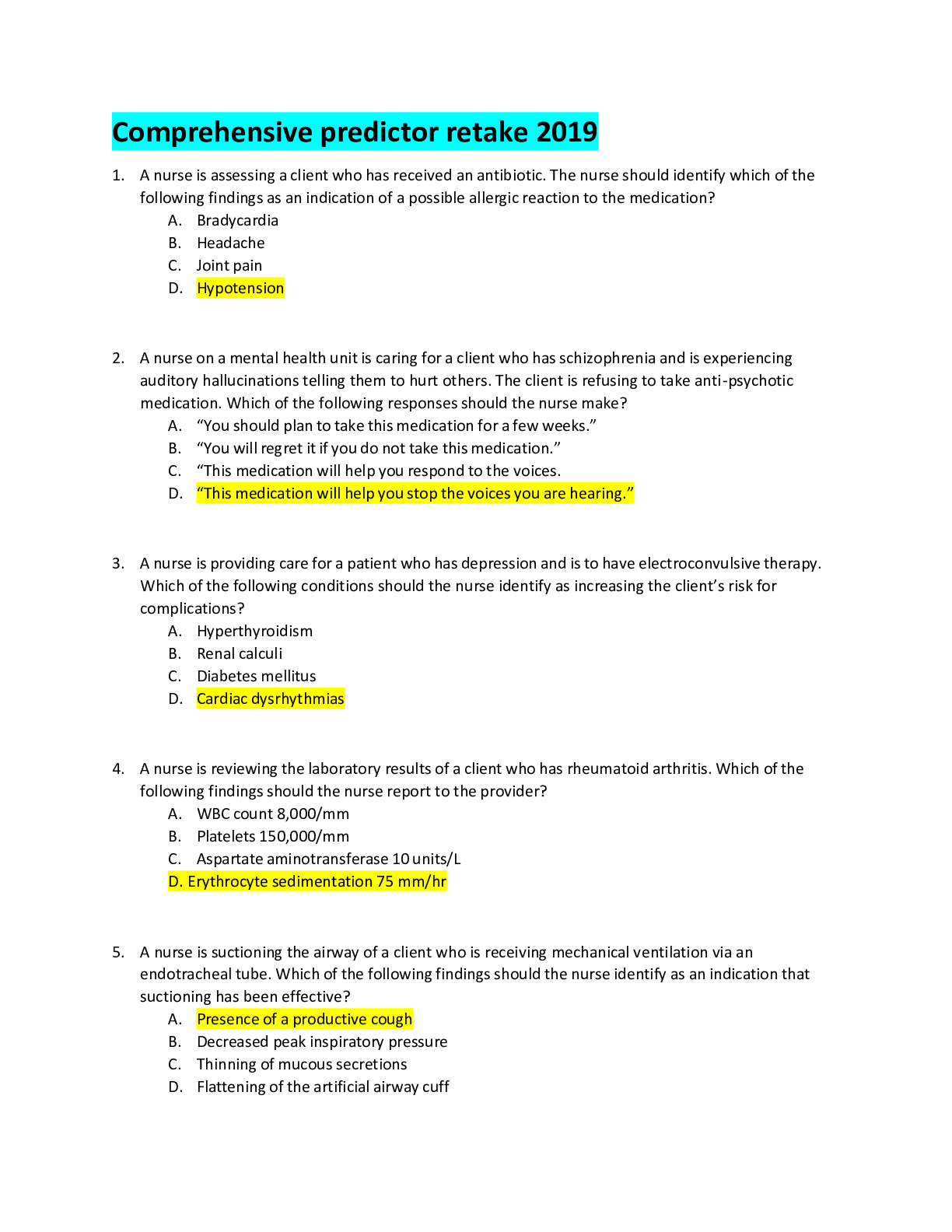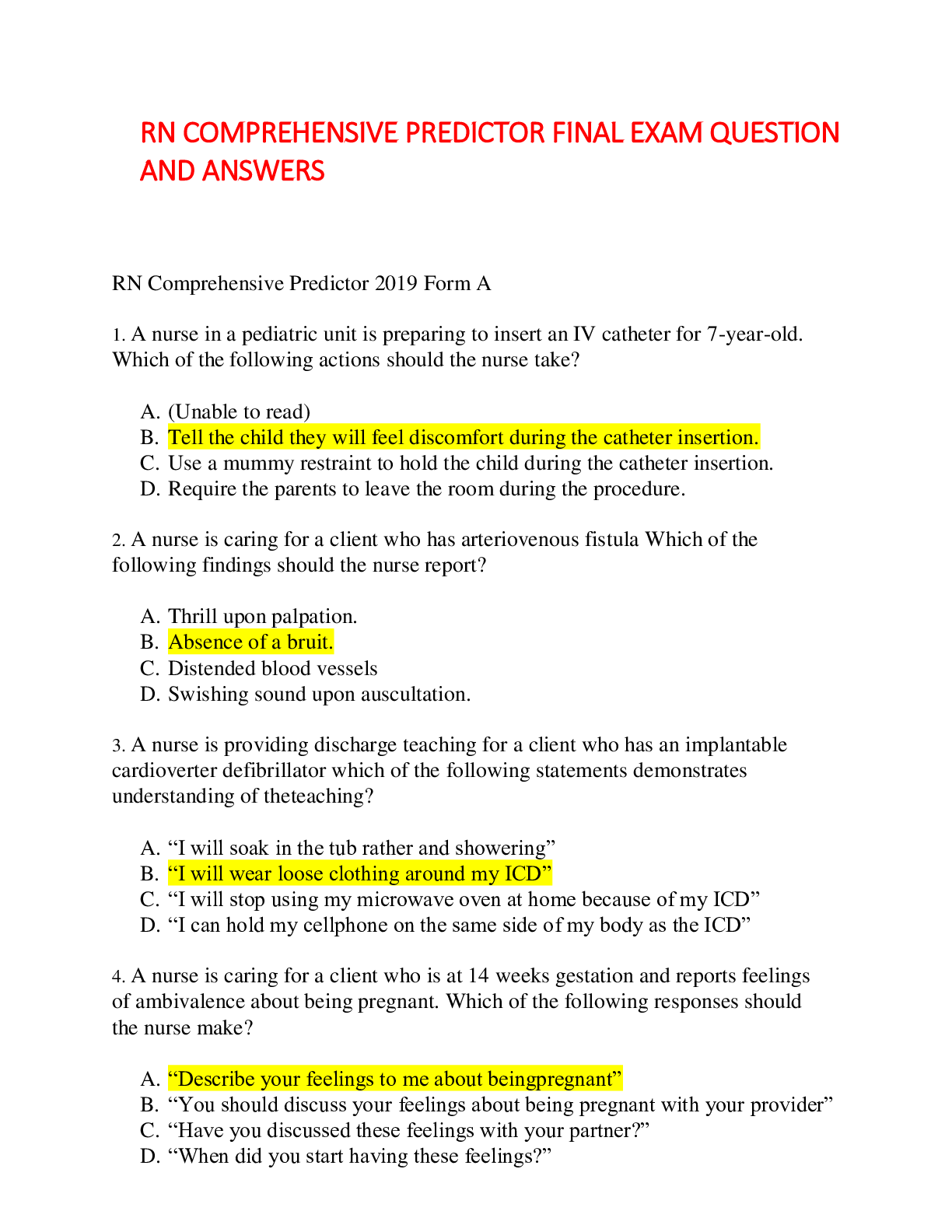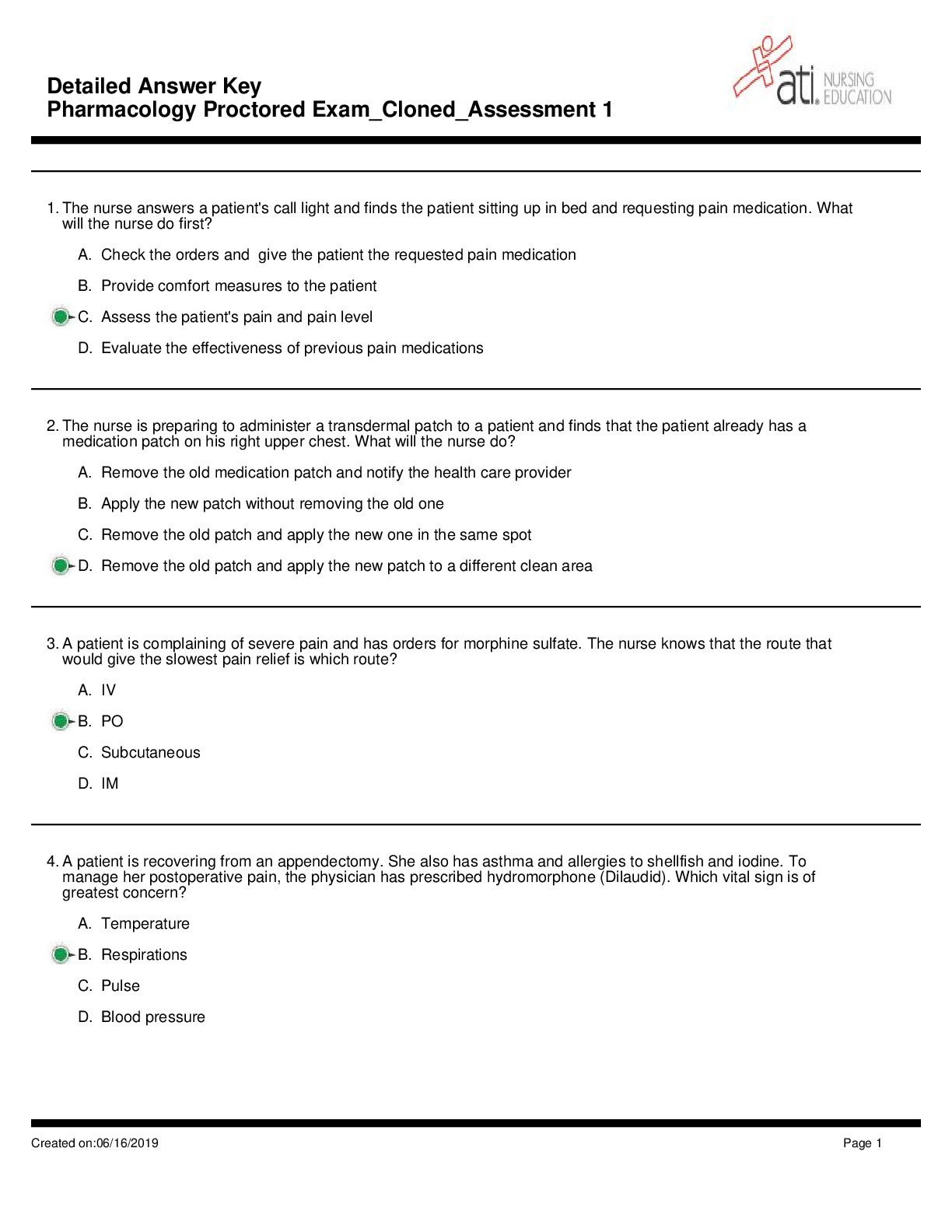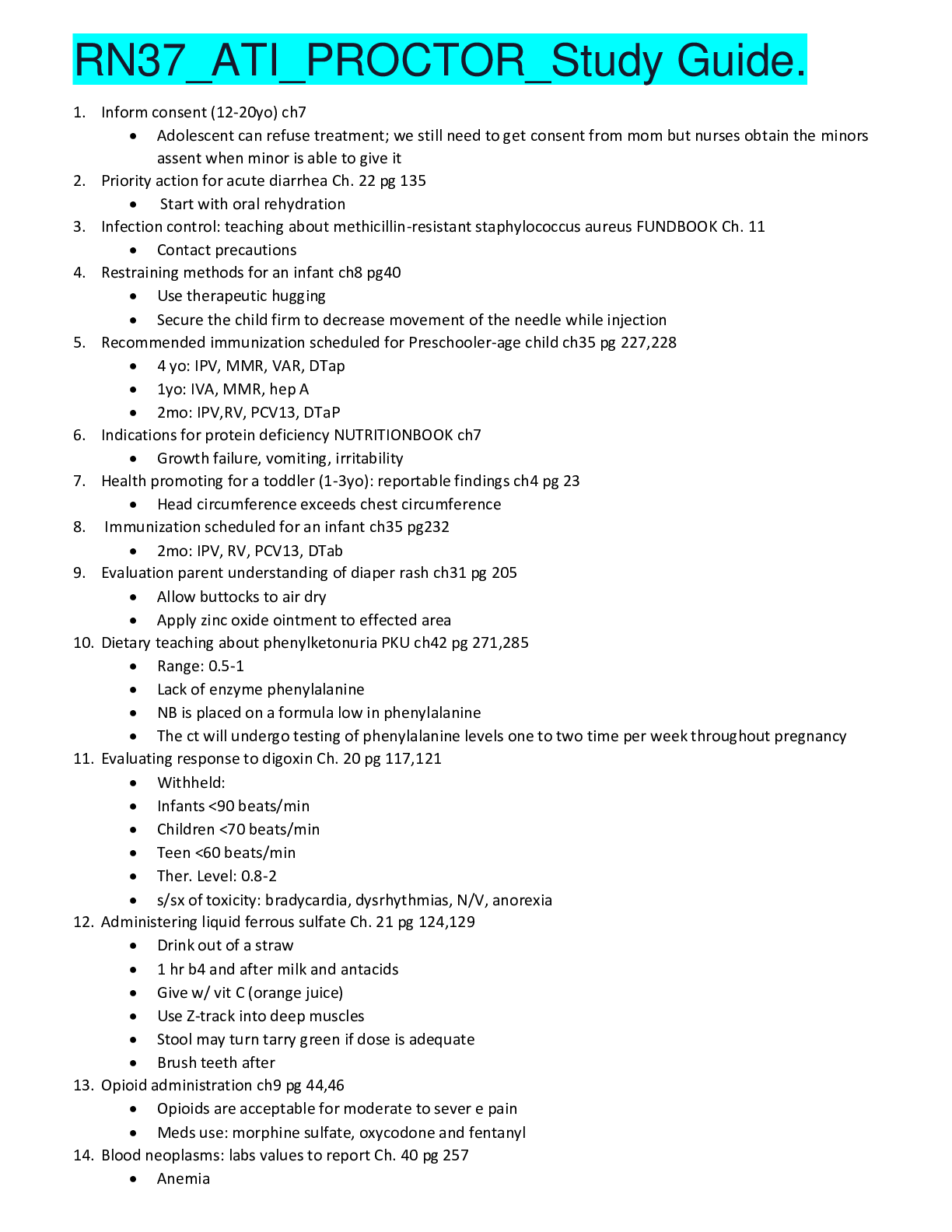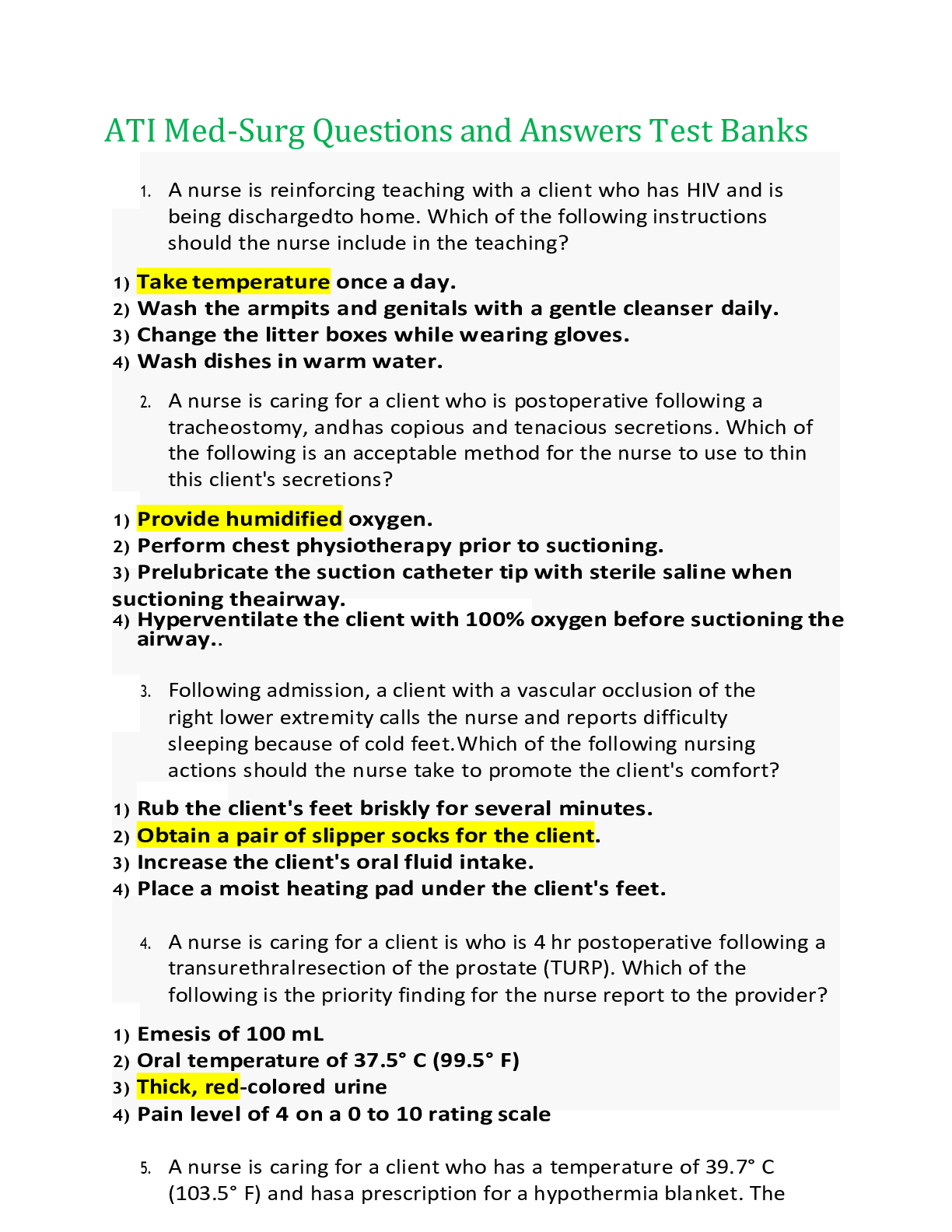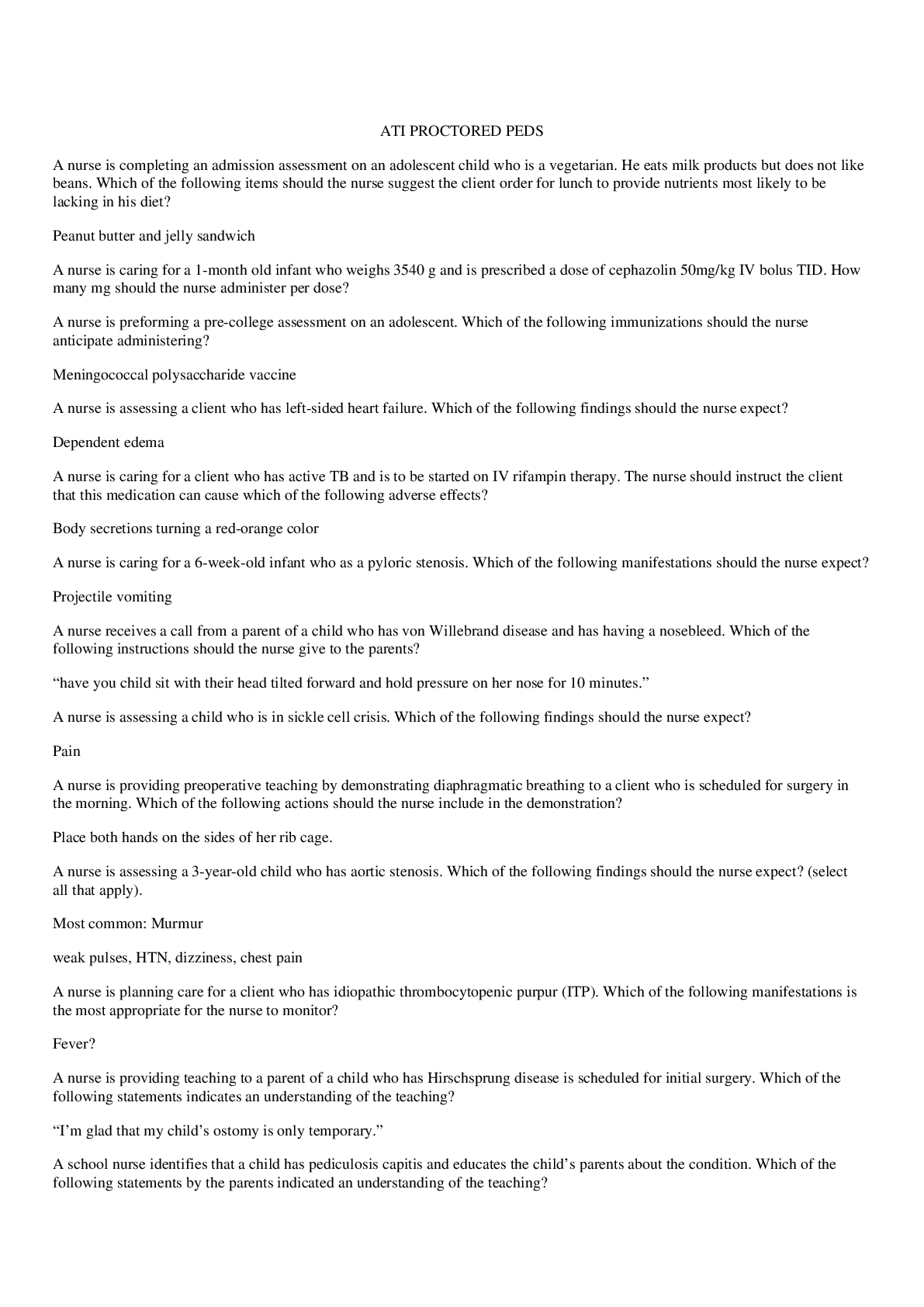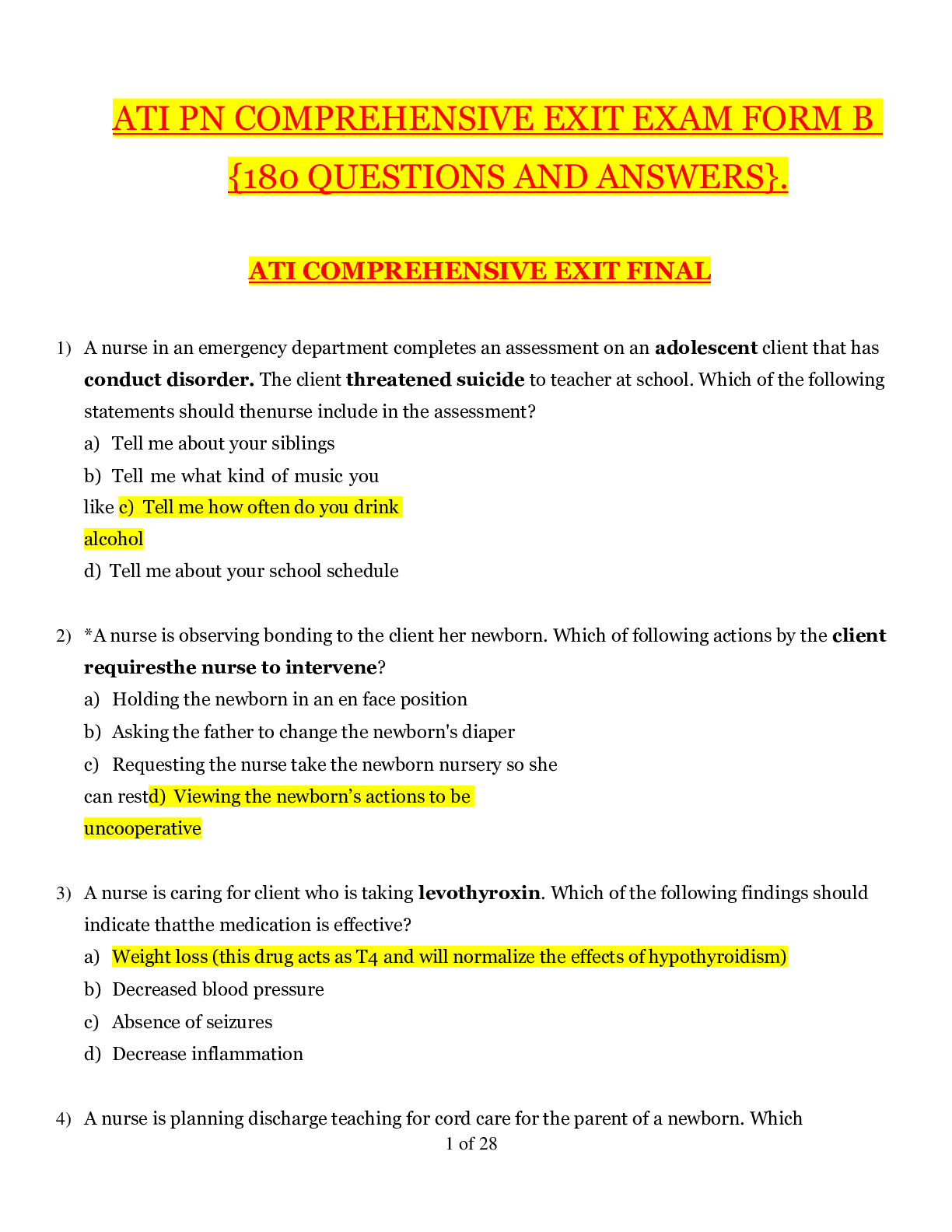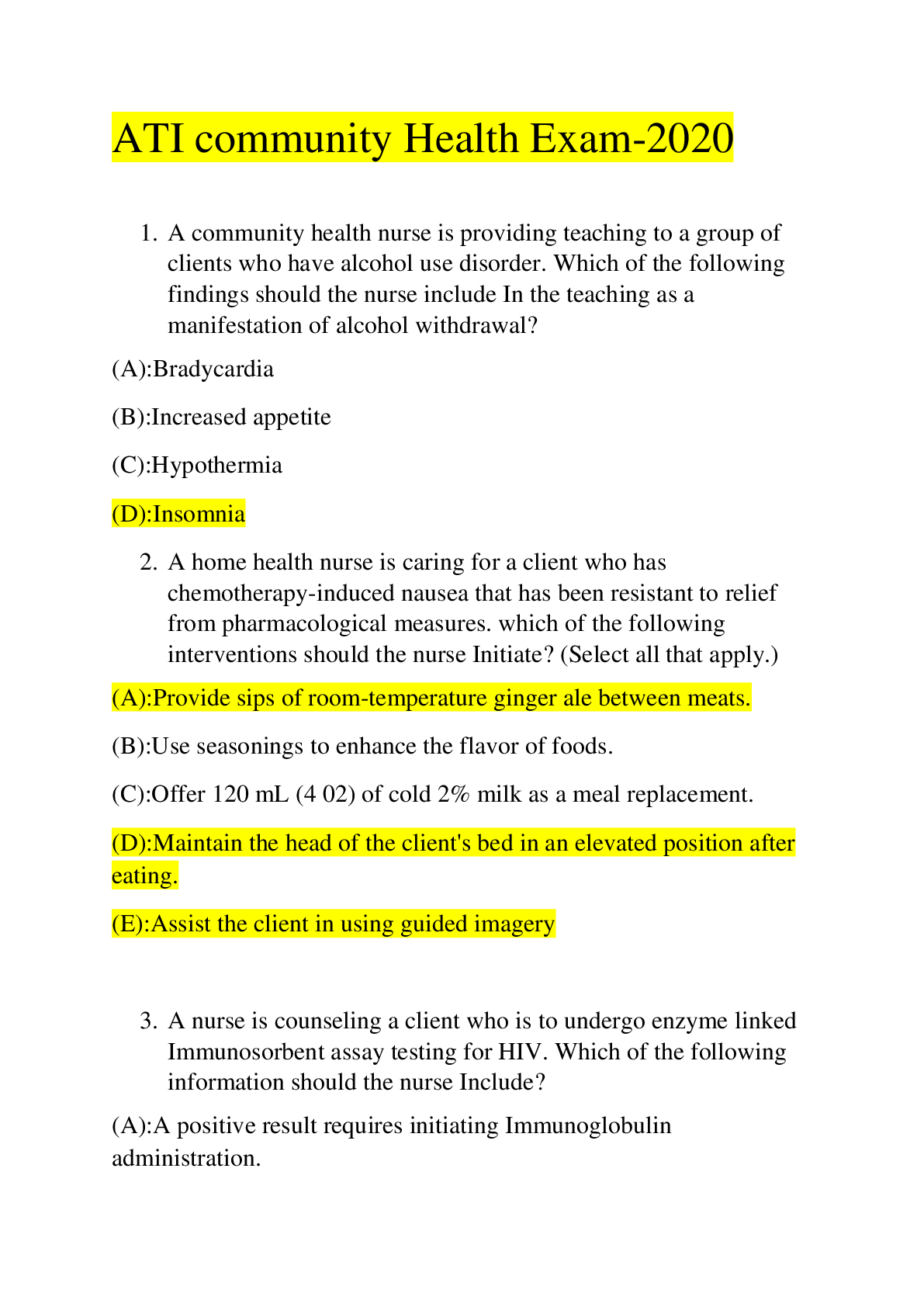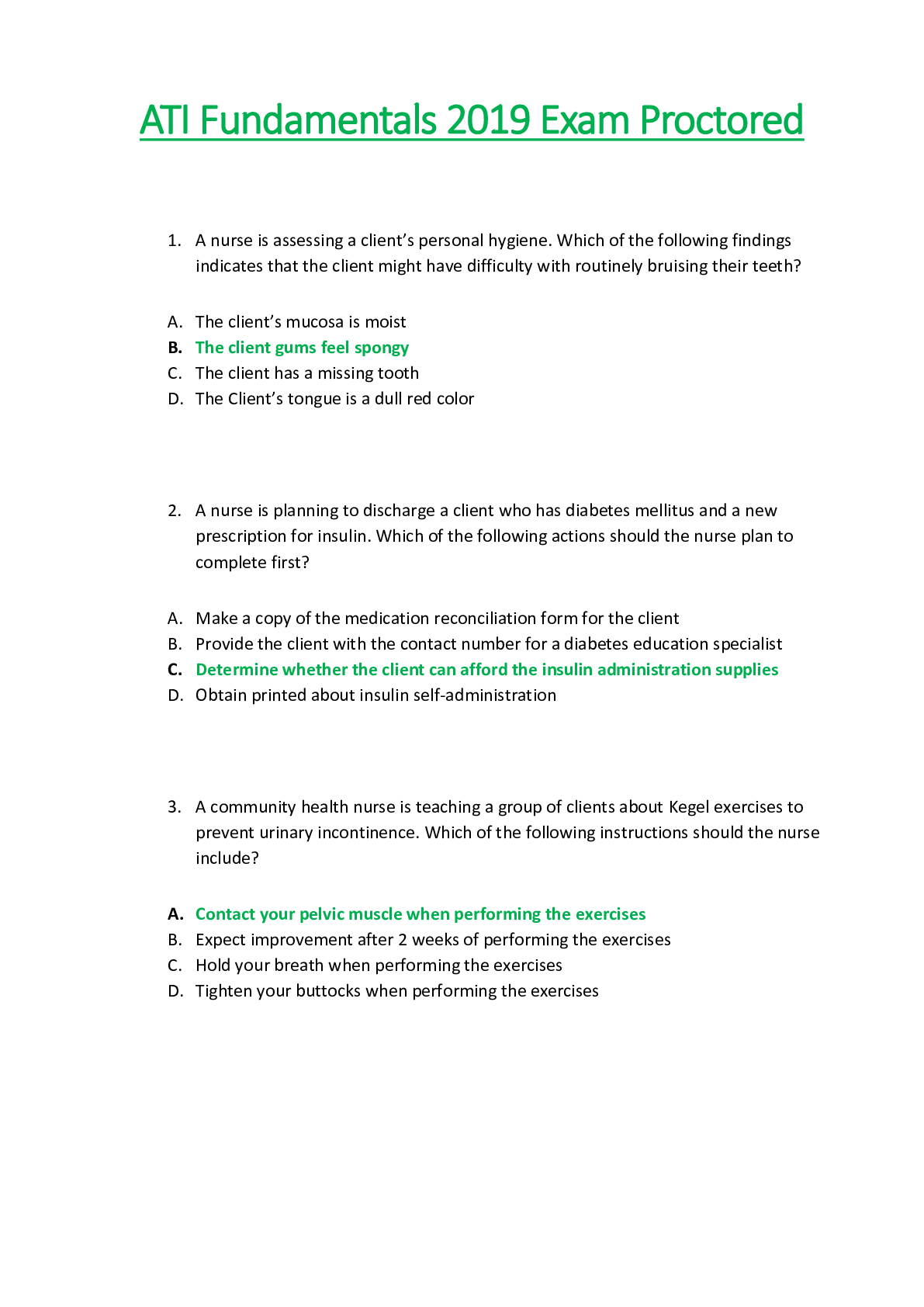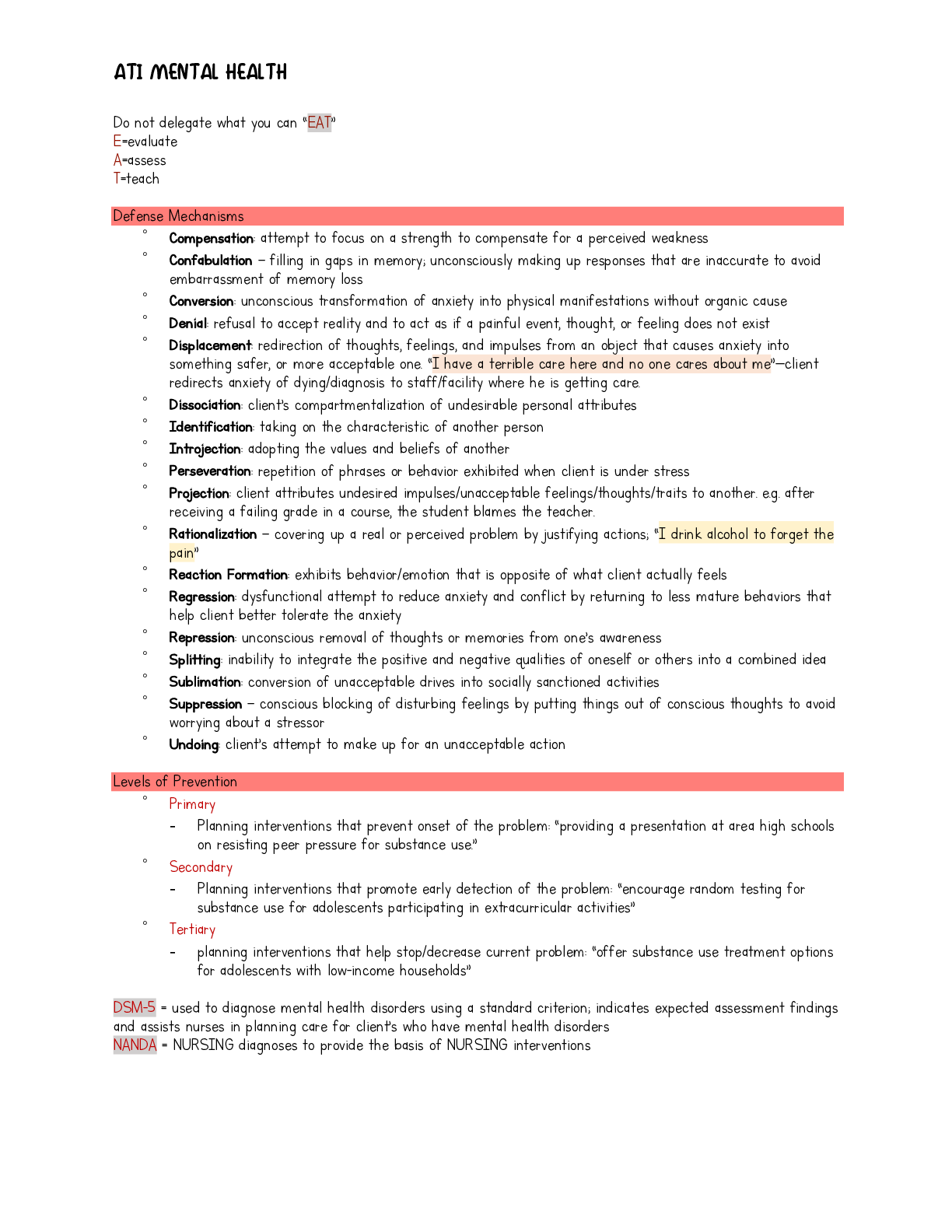*NURSING > EXAM PROCTORED > Pharmacology ATI (complete latest solution) 100% A+ grade. Exam (elaborations) (All)
Pharmacology ATI (complete latest solution) 100% A+ grade. Exam (elaborations)
Document Content and Description Below
Pharmacology ATI A nurse is caring for a pregnant client who is scheduled to have a contraction stress test (CST). The nurse should anticipate administering which of the following medications? ... A nurse is caring for a client who is prescribed ergotamine tartrate (Ergomar). The nurse should recognize that ergotamine tartrate is indicated for which of the following? A primary care provider has prescribed 250 mg PO Q6H of a medication for a client. The label reads 50 mg/mL. How many mL should the client receive in a 24 hour period? A nurse is taking a medication history on a client who is to receive a first dose of ceftriaxone (Rocephin). Which of the following allergies should the nurse report to the primary care Clients with allergies to piperacillin sodium, a penicillin, may have a cross-sensitivity to Ceftriaxone, a third-generation cephalosporin. This should be reported to the primary care provider. A nurse is caring for a client who is to start epoetin alfa (Epogen) for chronic renal failure. The nurse should recognize that the epoetin alfa is used to do which of the following? Treat anemia. Epoetin alfa is used to stimulate erythropoiesis in the bone marrow to increase red blood cell production. After taking erythromycin (Erythrocin) PO for 7 days, a client develops oral candidiasis. The nurse should recognize that this is most likely due to which of the following? Superinfection. The candida fungus is normally present in the mouth. The antibiotic effect of erythromycin allows the fungus to grow out of control which results in a superinfection. Erythromycin toxicity would be manifested by hearing loss (rare) or hepatotoxicity. A nurse receives a prescription to increase a procainamide (Pronestyl) IV infusion to 4 mg/min. The IV bag is labeled Pronestyl 2 g in 500 mL D5W. The nurse will adjust the IV pump to what rate? A nurse is assessing a client in the clinic who is on tamoxifen (Nolvadex). The nurse should recognize that tamoxifen has which of the following actions? Tamoxifen is an anti-estrogenic medication used to treat cancer of the breast in both pre- and post-menopausal women. It has been shown to delay recurrences. Tamoxifen is not androgenic. Androgens are the male hormones used to treat breast cancer. When administering diphenoxylate and atropine (Lomotil) to a client with ulcerative colitis, the nurse should monitor the client for the development of: A nurse should be aware that metoclopramide (Reglan) is contraindicated for a client who: Has an intestinal obstruction. Reglan promotes gastric emptying; it should not be given to a client with an intestinal obstruction. Reglan may be used to control vomiting associated with chemotherapy and postoperatively. When preparing the discharge plan for a client who has been on long term prednisone (Deltasone) therapy, the nurse should be aware that such clients are at risk for which of the following? Prednisone is a corticosteroid, or an synthetic glucocorticoid. Prednisone causes demineralization of the bones and leads to osteoporosis and stress fractures. A nurse is providing teaching to a client who is to start taking allopurinol (Zyloprim). For which of the following side effects should the nurse instruct the client to discontinue taking the medication? A client is being treated with a 10-day course of gentamicin sulfate (Garamycin). Which of the following findings should indicate to the nurse that the client is experiencing an adverse effect of this medication? Proteinuria. Gentamicin can lead to nephrotoxicity. Proteinuria is an indication that renal damage has occurred. The nurse is caring for a client who has had an acute myocardial infarction. The client is taking chlorothiazide (Diuril) 500 mg and digoxin (Lanoxin) 0.25 mg daily. The nurse should plan to monitor the client for which of the following? The client is at risk for hypokalemia due to fluid loss from chlorothiazide, which places him at greater risk for digoxin toxicity. Muscle weakness is a sign of hypokalemia. The client is at risk for hypokalemia, which would result in hypoactive reflexes. A nurse is caring for an older adult client who has been diagnosed with depression and is prescribed tricyclic antidepressant amitriptyline (Elavil). Which of the following diagnostic tests should the nurse anticipate will be ordered prior to starting the client on this medication? ECG (elctrocardiogram) The primary care provider has prescribed a continuous enteral feeding of half strength Ensure, which comes in eight ounce cans, to begin infusing at 75 mL/hr. How much water should the nurse add to the can of Ensure to complete the health care provider's prescription? In order to deliver a half-strength concentration, the feeding must be diluted with equal amounts of water. Consequently, for 240 mL (8 oz x 30 mL/oz) of formula, 240 mL of water would be added. A nurse is caring for a client taking filgrastim(Neupogen)and is reviewing the client's morning complete blood count (CBC) and differential. In evaluating the client's response to filgrastim, the nurse should review the: A nurse is reviewing the admission prescriptions for a client who has just been admitted from the emergency room with a prescription for clopidogrel (Plavix). Which of the following precautions should the nurse plan to implement? Plavix is an antithrombotic and antiplatelet aggregate used to lessen the chance of heart attack or stroke. Bleeding precautions attempt to limit client exposure to injury causing events that may lead to internal or external bleeding. A nurse is preparing to administer a morphine sulfate IV to a client for pain. The nurse should expect the onset of pain relief for the client to take place in: The IV route is considered to be the fastest and onset of pain relief usually begins in 10-15 min. A nurse is caring for an older adult client who is prescribed zolpidem (Ambien) at bedtime to help promote sleep. The nurse should plan to monitor the client for which of the following? An older adult client prescribed zolpidem is at risk for developing confusion. A client has been taking isoniazid (INH) and rifampin (Rifadin) for 3 weeks after being diagnosed with active pulmonary tuberculosis (TB). The client calls the clinic to report that his urine is a reddish orange color. Which of the following is an appropriate response by the nurse? Rifampin may turn all body fluids orange-red. This is a harmless side effect. Rifampin will turn body fluids, such as tears, sweat, saliva, and urine, an orange-red color. Advise the client that this effect does not cause harm. A nurse is providing teaching to the parents of a child who is prescribed valproic acid (Depakene) for seizures. The nurse instructs the parents that it will be necessary for the child to return to the clinic in 2 weeks to have which of the following diagnostic tests performed? (Select all that apply.) A nurse is caring for a client who is receiving heparin IV therapy. The morning aPTT is 90 seconds (control of 26). Which of the following actions should the nurse take first?T Turn off infusion. A nurse is caring for a client receiving heparin for deep vein thrombosis (DVT) prophylaxis. The nurse correctly delivers the heparin by: Using the subcutaneous sites in the abdomen. The preferred site for heparin injection is the subcutaneous tissue of the abdomen. Heparin should be administered with a 25 gauge or smaller needle to decrease the risk of hemorrhage. . A client who is taking chlorpromazine hydrochloride (Thorazine) is experiencing extreme restlessness and involuntary movements. To treat these side effects, the nurse should anticipate administering which of the following medications? A nurse is caring for a client with peptic ulcer disease. Which of the following medications should the nurse expect to administer for a headache? A nurse should recognize that aspirin therapy is contraindicated for children with viral illnesses due to the increased risk of which of the following? Reye's syndrome. Reyes syndrome has an increased incidence in children or adolescents who take aspirin during a viral illness, such as the flu or chickenpox. A client who is admitted with cirrhosis is prescribed lactulose (Cephulac) PO. For which of the following actions should the nurse administer lactulose? A nurse is caring for a client with pregnancy induced hypertension (PIH) who is started on a magnesium sulfate IV. Which of the following should the nurse recognize as the priority assessment finding? A nurse is caring for a client prescribed amphotericin B(Fungizone). Which of the following should the nurse recognize as the best indicator of renal function? A primary care provider prescribes an infusion of a hypertonic solution. Which of the following intravenous solutions should the nurse anticipate administering? A client with a urinary tract infection (UTI) is being discharged on phenazopyridine (Pyridium) and ciprofloxacin hydrochloride (Cipro). Which of the following statements by the client should indicate to the nurse a need for further teaching? When administering the first dose of enalapril maleate (Vasotec) to a client, which of the following should the nurse recognize as the priority assessment? BP. When taking the first dose of enalapril, the greatest risk to the client is orthostatic hypotension. Therefore, the priority assessment is blood pressure. A nurse is providing teaching to a client receiving gemfibrozil (Lopid). The nurse evaluates effectiveness of the teaching when the client states he will have which of the following evaluated periodically? A nurse is caring for a preschool-age child in the emergency department who has dyspnea, wheezing, and a history of severe asthma. The health care provider prescribes epinephrine hydrochloride (Adrenalin) subcutaneously stat. After the drug is administered, the nurse should assess the client for: A nurse is providing teaching to a client who is prescribed hydrochlorothiazide (Oretic) for hypertension. The nurse should instruct the client to take the medication: In the morning. Clients should be instructed to take hydrochlorothiazide, a diuretic, in the morning to allow for diuresis during the day without interfering with sleep. A nurse is providing teaching to the parent of a child with asthma who is prescribed cromolyn sodium (Intal) via metered dose inhaler. Which of the following statements by the child's parent should indicate to the nurse the need for further instruction? A nurse is caring for a pregnant client who is scheduled to have a contraction stress test (CST). The nurse should anticipate administering which of the following medications? A nurse is caring for a client who is prescribed ergotamine tartrate (Ergomar). The nurse should recognize that ergotamine tartrate is indicated for which of the following? A primary care provider has prescribed 250 mg PO Q6H of a medication for a client. The label reads 50 mg/mL. How many mL should the client receive in a 24 hour period? 20mL A nurse is taking a medication history on a client who is to receive a first dose of ceftriaxone (Rocephin). Which of the following allergies should the nurse report to the primary care provider? Clients with allergies to piperacillin sodium, a penicillin, may have a cross-sensitivity to Ceftriaxone, a third-generation cephalosporin. This should be reported to the primary care provider. A nurse is caring for a client who is to start epoetin alfa (Epogen) for chronic renal failure. The nurse should recognize that the epoetin alfa is used to do which of the following? Treat anemia. Epoetin alfa is used to stimulate erythropoiesis in the bone marrow to increase red blood cell production. After taking erythromycin (Erythrocin) PO for 7 days, a client develops oral candidiasis. The nurse should recognize that this is most likely due to which of the following? Superinfection. The candida fungus is normally present in the mouth. The antibiotic effect of erythromycin allows the fungus to grow out of control which results in a superinfection. Erythromycin toxicity would be manifested by hearing loss (rare) or hepatotoxicity. A nurse receives a prescription to increase a procainamide (Pronestyl) IV infusion to 4 mg/min. The IV bag is labeled Pronestyl 2 g in 500 mL D5W. The nurse will adjust the IV pump to what rate? A nurse is assessing a client in the clinic who is on tamoxifen (Nolvadex). The nurse should recognize that tamoxifen has which of the following actions? Anti-estrogenic. Tamoxifen is an anti-estrogenic medication used to treat cancer of the breast in both pre- and post-menopausal women. It has been shown to delay recurrences. Tamoxifen is not androgenic. Androgens are the male hormones used to treat breast cancer. When administering diphenoxylate and atropine (Lomotil) to a client with ulcerative colitis, the nurse should monitor the client for the development of: Toxic megacolon. A nurse should be aware that metoclopramide (Reglan) is contraindicated for a client who: Has an intestinal obstruction. Reglan promotes gastric emptying; it should not be given to a client with an intestinal obstruction. Reglan may be used to control vomiting associated with chemotherapy and postoperatively. When preparing the discharge plan for a client who has been on long term prednisone (Deltasone) therapy, the nurse should be aware that such clients are at risk for which of the following? Prednisone is a corticosteroid, or an synthetic glucocorticoid. Prednisone causes demineralization of the bones and leads to osteoporosis and stress fractures. A nurse is providing teaching to a client who is to start taking allopurinol (Zyloprim). For which of the following side effects should the nurse instruct the client to discontinue taking the medication? A client is being treated with a 10-day course of gentamicin sulfate (Garamycin). Which of the following findings should indicate to the nurse that the client is experiencing an adverse effect of this medication? Proteinuria. Gentamicin can lead to nephrotoxicity. Proteinuria is an indication that renal damage has occurred. The nurse is caring for a client who has had an acute myocardial infarction. The client is taking chlorothiazide (Diuril) 500 mg and digoxin (Lanoxin) 0.25 mg daily. The nurse should plan to monitor the client for which of the following? Muscle weakness. The client is at risk for hypokalemia due to fluid loss from chlorothiazide, which places him at greater risk for digoxin toxicity. Muscle weakness is a sign of hypokalemia. The client is at risk for hypokalemia, which would result in hypoactive reflexes. A nurse is caring for an older adult client who has been diagnosed with depression and is prescribed tricyclic antidepressant amitriptyline (Elavil). Which of the following diagnostic tests should the nurse anticipate will be ordered prior to starting the client on this medication? The primary care provider has prescribed a continuous enteral feeding of half strength Ensure, which comes in eight ounce cans, to begin infusing at 75 mL/hr. How much water should the nurse add to the can of Ensure to complete the health care provider's prescription? 240mL In order to deliver a half-strength concentration, the feeding must be diluted with equal amounts of water. Consequently, for 240 mL (8 oz x 30 mL/oz) of formula, 240 mL of water would be added. A nurse is caring for a client taking filgrastim(Neupogen)and is reviewing the client's morning complete blood count (CBC) and differential. In evaluating the client's response to filgrastim, the nurse should review the: The client is to receive 1 L of Ringer's Lactate (LR) IV over 8 hr. The drip factor on the IV tubing is 10 gtt/mL. What rate should the nurse set the IV to deliver the fluid as prescribed? 21gtt/min. Formular for gtt/min= volume (mL)/time (min)* drop factor. The client needs to receive 1 L over 8 hr. You know that 1 L = 1,000 mL. 1,000 mL/8 hr is 125 mL/hr. 125 (mL/hr) x 10 (gtt/mL)/by 60 (min/hour) = 20.83. Using rounding rules, 20.83 = 21 gtt/min. A nurse is reviewing the admission prescriptions for a client who has just been admitted from the emergency room with a prescription for clopidogrel (Plavix). Which of the following precautions should the nurse plan to implement? Bleeding. Plavix is an antithrombotic and antiplatelet aggregate used to lessen the chance of heart attack or stroke. Bleeding precautions attempt to limit client exposure to injury causing events that may lead to internal or external bleeding. A nurse is preparing to administer a morphine sulfate IV to a client for pain. The nurse should expect the onset of pain relief for the client to take place in: 10-15min. An older adult client prescribed zolpidem is at risk for developing confusion. A client has been taking isoniazid (INH) and rifampin (Rifadin) for 3 weeks after being diagnosed with active pulmonary tuberculosis (TB). The client calls the clinic to report that his urine is a reddish orange color. Which of the following is an appropriate response by the nurse? Rifampin may turn all body fluids orange-red. This is a harmless side effect. Rifampin will turn body fluids, such as tears, sweat, saliva, and urine, an orange-red color. Advise the client that this effect does not cause harm. A nurse is caring for a client who is receiving heparin IV therapy. The morning aPTT is 90 seconds (control of 26). Which of the following actions should the nurse take first?T A nurse is caring for a client receiving heparin for deep vein thrombosis (DVT) prophylaxis. The nurse correctly delivers the heparin by: A client who is taking chlorpromazine hydrochloride (Thorazine) is experiencing extreme restlessness and involuntary movements. To treat these side effects, the nurse should anticipate administering which of the following medications? Amatadine (Symmetrel) A nurse is caring for a client with peptic ulcer disease. Which of the following medications should the nurse expect to administer for a headache? A nurse should recognize that aspirin therapy is contraindicated for children with viral illnesses due to the increased risk of which of the following? Reye's syndrome. Reyes syndrome has an increased incidence in children or adolescents who take aspirin during a viral illness, such as the flu or chickenpox. A client who is admitted with cirrhosis is prescribed lactulose (Cephulac) PO. For which of the following actions should the nurse administer lactulose? A nurse is caring for a client with pregnancy induced hypertension (PIH) who is started on a magnesium sulfate IV. Which of the following should the nurse recognize as the priority assessment finding? A primary care provider prescribes an infusion of a hypertonic solution. Which of the following intravenous solutions should the nurse anticipate administering? A client with a urinary tract infection (UTI) is being discharged on phenazopyridine (Pyridium) and ciprofloxacin hydrochloride (Cipro). Which of the following statements by the client should indicate to the nurse a need for further teaching? When administering the first dose of enalapril maleate (Vasotec) to a client, which of the following should the nurse recognize as the priority assessment? BP. When taking the first dose of enalapril, the greatest risk to the client is orthostatic hypotension. Therefore, the priority assessment is blood pressure. A nurse is providing teaching to a client receiving gemfibrozil (Lopid). The nurse evaluates effectiveness of the teaching when the client states he will have which of the following evaluated periodically? A nurse is caring for a preschool-age child in the emergency department who has dyspnea, wheezing, and a history of severe asthma. The health care provider prescribes epinephrine hydrochloride (Adrenalin) subcutaneously stat. After the drug is administered, the nurse should assess the client for: . Adverse effects of epinephrine hydrochloride include rapid heart rate and high blood pressure. The health care provider prescribes IV therapy for a client with deep vein thrombosis (DVT). The prescription states: heparin sodium 20,000 Units in 1000 mL 0.9% sodium chloride IV to infuse at 1,000 Units/hr via IV pump. How many mL per hr should be administered by the nurse to give the dose prescribed? A nurse is providing teaching to a client who is prescribed hydrochlorothiazide (Oretic) for hypertension. The nurse should instruct the client to take the medication: In the morning. Clients should be instructed to take hydrochlorothiazide, a diuretic, in the morning to allow for diuresis during the day without interfering with sleep. A nurse is providing teaching to the parent of a child with asthma who is prescribed cromolyn sodium (Intal) via metered dose inhaler. Which of the following statements by the child's parent should indicate to the nurse the need for further instruction? [Show More]
Last updated: 1 year ago
Preview 1 out of 18 pages
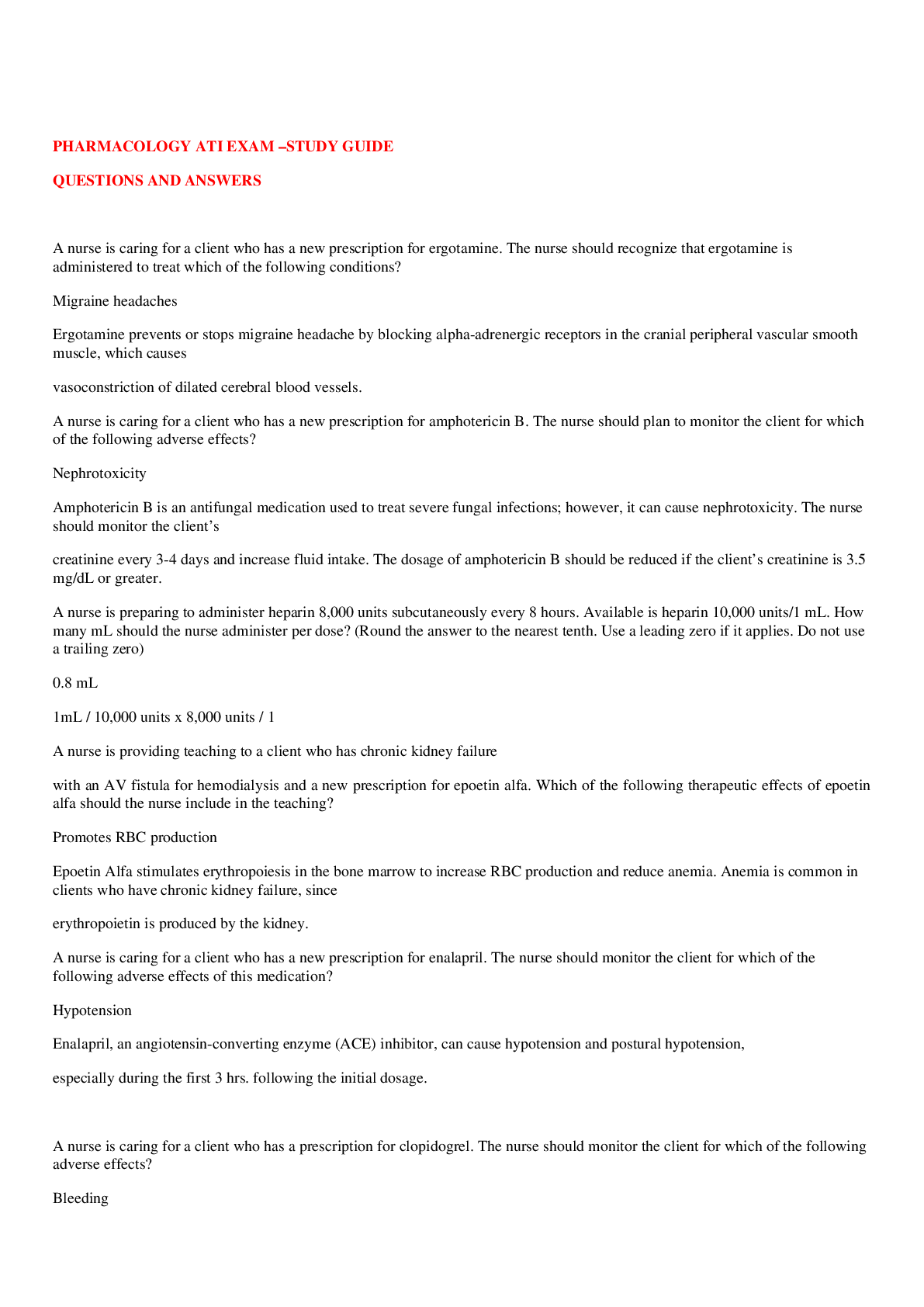
Reviews( 0 )
Document information
Connected school, study & course
About the document
Uploaded On
Nov 25, 2020
Number of pages
18
Written in
Additional information
This document has been written for:
Uploaded
Nov 25, 2020
Downloads
0
Views
118



